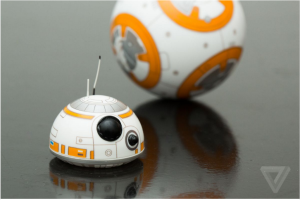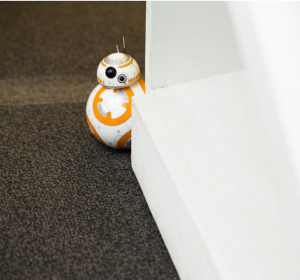As I write this, holed up in a small office, I can hear a quiet whirr going to and fro on the floor. Actually, it’s more of a quiet whirr followed by a less quiet thunk as plastic meets plaster wall, followed by a brief intermission where my aural focus shifts to the various emotive beeps emanating from my phone’s speaker.
This may be the oddest way to “enjoy” a toy — it’s certainly one of the most passive — but Sphero’s BB-8 isn’t a toy so much as it is a very simple robot performer with Pixar-esque aspirations. The $149.99 droid will go on sale starting this Friday at Apple’s retail stores, Best Buy, and Sphero’s own website (don’t worry, it’s Android compatible, too). That’s a pretty hefty price tag, but Sphero’s BB-8 is offering something few Star Wars toys have been able to pull off: it captures the personality of the droid, and it speaks volumes to where Sphero wants to try and push robotics in the future.

If trailers are meant to generate hype for a film, a Star Wars trailer serves to tease an entire cross-media entertainment platform. Since the beginning, the mythos of Star Wars has been equal parts on-screen movie magic and off-screen merchandising. In the ‘70s and ‘80s, it was largely dominated by Kenner action figures, and though Star Wars merchandising has remained a massive force — in 2011 alone, the license made an estimated $3 billion — this year is poised to be exceptionally large, thanks in no small part to The Force Awakens, the first new Star Wars film since 2005’s Revenge of the Sith. The hot new items from those Force Awakens trailers? A cross-guard lightsaber and a really cute soccer ball with a robot head. It’s a big enough moment in Star Wars fandom that Disney has made a global event out of unboxing all the tie-in toys — an event that is being branded as "Force Friday."
STAR WARS HAS ALWAYS BEEN EQUAL PARTS FILM AND MERCHANDISE
But while this kind of fanfare is maybe old hat for Hasbro and Lego, it’s a fairly new feeling for Sphero. The company was founded in 2010 (then called Orbotix) and has released a handful of products since: the titular Sphero (an orb you can control with your phone), the cylindrical bot Ollie, and a few variations of each — all intriguing ideas, but nothing that found mainstream commercial success. With the BB-8 toy, that’s all about to change.
Sphero’s collaboration with Disney began last summer when it joined the Disney Accelerator program. It’s a rather odd move for a four-year-old company with commercially released products, but it was clearly a smart one. As chief creative officer Rob Maigret tells us, one of Sphero’s mentors was none other than Disney CEO Bob Iger, who has shown a knack for acquiring strong (read: profitable) talent, including Pixar, Marvel, and Lucasfilm. (Maigret himself was the other mentor, joining the company after the program.) At their first meeting, Iger (reportedly) showed the Sphero co-founders a picture of BB-8 and challenged them to make a working version, which the duo (again, reportedly) managed to conceptualize in about 24 hours’ time. (The version on film, however, is more puppetry than robotics.)

It’s no surprise that the base of BB-8 is essentially the company’s flagship product with a glossy, Star Wars-y paint job. The biggest outward addition is the headpiece — a piece of plastic with tiny wheels "attached" magnetically to the orb. (For those who want to nitpick, the head is proportionally smaller than its on-screen doppelgänger.) It’s a key addition and one that, much like the film model, gives BB-8 its personality. Much like John Lasseter’s classic animated short film Red’s Dream, which starred a unicycle, having just a little bit of articulation lets BB-8 emote in identifiable ways.
As with past Sphero products, your smartphone is essential to interacting with BB-8: all interfacing (and indeed all of the sound effects) happens via an iOS or Android device. BB-8 can be imprecise — I dare say "moody" — in how it responds to manual driving. That’s especially true when you first get it moving; there seems to be a preprogrammed maneuver where it goes backwards for a few seconds too long, as if it’s "winding up" to move (and to be fair, this thing's top speed is pretty damn fast). Once it’s in motion, however, steering becomes fairly intuitive. BB-8 also has several patterns you can trigger, such as a figure eight, but more importantly, it can be prompted to convey several "emotions" like nodding yes, shaking its head no, and something that’s either joy or panic, I’m still not sure which. You can reportedly use voice commands to drive it as well, although we couldn’t get it to work in the early build of the app we used.
Then there’s patrol mode. Left to its own devices, BB-8 wanders around the room without directive. It doesn’t have a camera (again, the head is just plastic), so for the most part it’ll just drive around until it hits a wall, act pissy (that’s my interpretation at least), and then go another direction. I wouldn’t recommend letting it on tables or other elevated surfaces, but if you do, it's worth noting that the thing's been pretty durable so far. (Its effectiveness on carpet is variable, pending your floor fabric of choice.)
Sphero makes a lot of bold claims on the packaging, chief among them "holographic communication," but really it’s just an augmented reality video — either of an X-Wing model or some small video you record with a front-facing camera — that you can see by pointing. It’s cute, but you’ll probably only try it once.

But for all the added bells and whistles, the BB-8's primary directive is really just to be a ball of cuteness — to make you feel something and ascribe emotion to an algorithmically driven device. Even when you’re not using BB-8, the droid will start looking around, as if it’s impatiently waiting for you to give it directions. The first time I set it down in its charging stand, it suddenly began "looking around," twisting and moving its head erratically as if it’s trying to ascertain its environment. It was a jarring moment for myself and a few other co-workers, too, but it speaks to Sphero’s renewed focus on giving its products personality. "We think this is probably the first step for Sphero," said Maigret, reflecting on the company’s rather ambitious goals for the future. "We think that ultimately there will be a robot in every house — that everyone will own a companion."
Maigret knows those dreams are a ways off, but you can see the very, very early roots of those ideas in BB-8. As a new tier of Star Wars merchandising, the droid stands out as a desirable and capable.
There’s something earnestly fascinating about seeing it go off on its own. I can’t say how long that novelty will last, but I could easily see myself turning it on autopilot and enjoying the occasional moment where I catch it doing something weird and cute. It's kind of like a cat, in that respect.
"WE THINK THAT ULTIMATELY THERE WILL BE A ROBOT IN EVERY HOUSE — THAT EVERYONE WILL OWN A COMPANION."
But BB-8 also represents something new for Star Wars merchandising. Sure, other tie-ins over the years have hit or even exceeded the $150 mark, but in many ways, this feels like a different kind of luxury item — one, perhaps, for the generations that remember seeing Star Wars in theaters (be it Original Trilogy or the Prequels) and have a bit of disposable income now. This isn't a static action figure; Sphero's BB-8 is designed to move and emote even when you’re not actively engaging with it, which ultimately is the reason to consider it. And who knows? By the time Episode XXIV hits theaters, maybe we will have autonomous robot friends. For now, though, it’s just a ball of cuteness — a weirdly interesting ball of cuteness, though.